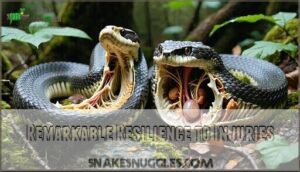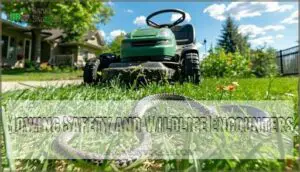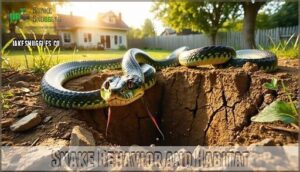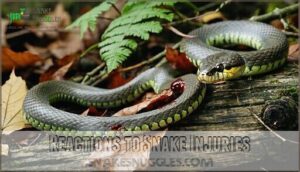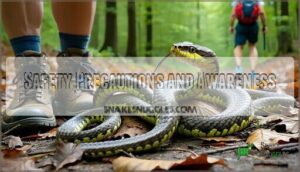This site is supported by our readers. We may earn a commission, at no cost to you, if you purchase through links.

When a snake is severed, massive trauma occurs instantly. The back half lacks essential organs like the heart and lungs, causing immediate death.
The front half faces rapid blood loss and organ failure. You’ll see post-mortem muscle contractions that might look like survival, but these are just nerve reactions.
Even with their impressive healing abilities, snakes can’t regenerate from such severe trauma. Blood loss triggers hypovolemic shock within minutes, and infection risks from exposed wounds accelerate death.
Neither half possesses the anatomical requirements for independent survival, despite snakes’ remarkable resilience to minor injuries.
Table Of Contents
- Key Takeaways
- Snake Anatomy and Physiology
- Consequences of Being Cut in Half
- Can Separated Halves Survive Independently?
- Snake Resilience and Recovery
- Mowing Safety and Wildlife Encounters
- Snake Behavior and Habitat
- Reactions to Snake Injuries
- Snake Survival and Mortality
- Safety Precautions and Awareness
- Frequently Asked Questions (FAQs)
- Can a snake survive if cut in half?
- What happens if a snake is cut in half?
- How long does a snake’s body last after being cut in half?
- Can a rat snake survive being cut in half?
- Should you sever a snake in half?
- Can a snake survive without medical intervention?
- Can a snake survive after being cut?
- Could a snake still survive if the head is cut off?
- Why should you never kill a snake?
- Can snakes heal from cuts?
- Conclusion
Key Takeaways
- You can’t rely on regeneration myths – snakes lack the biological ability to regrow severed body parts or survive being cut in half, unlike some lizards that can drop and regrow tails.
- Both halves die from organ failure – the back half lacks essential organs like the heart and lungs, while the front half experiences fatal blood loss and hypovolemic shock within minutes.
- Movement after cutting doesn’t mean survival – any twitching or movement you see is just post-mortem nerve reflexes, not signs of life or recovery.
- Prevention beats treatment – you’ll protect snakes best by mowing carefully during midday hours, wearing protective gear, and giving them space to escape rather than risking accidental injuries.
Snake Anatomy and Physiology
Understanding snake anatomy helps explain why severe injuries are fatal.
You’ll discover that snakes have elongated but interconnected organs – including a three-chambered heart, specialized lungs, and flexible skeletal systems – that work together as one integrated unit rather than independent parts.
Muscular Body and Scales
A snake’s muscular body acts like nature’s ultimate armor and movement machine.
Their scaly skin forms protective body armor while powerful muscle structure enables lightning-fast strikes.
The flexible backbone contains hundreds of vertebrae, creating fluid snake movement patterns.
This incredible reptile anatomy allows snakes to constrict prey, navigate tight spaces, and defend themselves effectively through coordinated muscular contractions and specialized skin protection.
Flexible Jaw and Stretchy Trachea
Your snake’s jaw structure releases incredible feeding power through remarkable elasticity mechanisms.
Unlike rigid human jaws, snakes possess highly flexible jaw connections that unhinge completely, allowing prey swallowing of animals much larger than their head.
Key snake feeding adaptations include:
- Stretchy trachea – moves forward during swallowing to maintain breathing
- Flexible jaw joints – disconnect to accommodate massive prey sizes
- Muscular body coordination – guides food through elongated digestive tract
This reptile anatomy enables survival in harsh environments where large meals are infrequent.
Three-Chambered Heart and Blood Circulation
Beyond their flexible jaws, snakes possess a remarkable three-chambered heart that powers their entire circulatory system.
This unique heart structure differs from mammals’ four-chambered hearts, featuring two atria and one ventricle that efficiently manages blood circulation throughout their elongated bodies.
Snake anatomy reveals fascinating adaptations for vascular health:
- Blood pressure remains consistent despite body position changes during movement
- Cardiac function adapts to support both resting and active hunting behaviors
- The circulatory system efficiently delivers oxygen to organs stretched along their spine
- Heart placement further back in the body optimizes snake physiology for flexibility
This specialized cardiovascular design enables snakes to maintain proper circulation while contorting through tight spaces, striking at prey, or remaining motionless for hours.
Understanding the snake characteristics guide is essential for appreciating these unique physiological adaptations.
Consequences of Being Cut in Half
When you cut a snake in half, you’re causing catastrophic damage that destroys multiple essential organ systems simultaneously.
Severing a snake means instant death – their interconnected organs can’t survive such catastrophic trauma
The snake experiences massive blood loss, respiratory failure, and complete breakdown of its nervous system, making survival impossible for either half of the severed body.
Massive Physical Trauma and Organ Damage
When you witness a snake being cut in half, catastrophic physical trauma occurs instantly.
The severed spinal cord causes immediate paralysis while massive blood loss from torn vessels triggers hypovolemic shock.
Exposed internal organs face environmental contamination, leading to rapid tissue damage and organ failure.
Snake anatomy can’t withstand such severe trauma – mortality rates approach 100% without emergency intervention.
Injury Effect on Snake Consequences
Disrupted Vital Organ Systems
When you cut a snake in half, you’re witnessing a complete biological breakdown.
The snake’s interconnected organ systems can’t function independently after severing.
- Organ Failure: Essential organs like the liver and kidneys stop working without proper blood circulation
- Respiratory Collapse: Damaged lung tissue and severed breathing muscles prevent oxygen intake
- Systemic Shock: Blood loss triggers immediate cardiovascular collapse, starving tissues of nutrients
Snake regeneration can’t overcome such massive tissue damage and organ damage.
Rapid Blood Loss and Hypovolemic Shock
Devastation strikes when blood loss occurs rapidly after severing. The three-chambered heart can’t maintain circulation, triggering hypovolemic shock within minutes.
Circulatory collapse follows as blood pressure plummets, starving organs of oxygen. This physical trauma creates an unstoppable cascade toward organ failure.
| Injury Severity | Blood Loss Rate | Shock Timeline |
|---|---|---|
| Complete Bisection | 40-60% per minute | 1-3 minutes |
| Partial Severing | 20-30% per minute | 3-5 minutes |
| Deep Laceration | 10-15% per minute | 5-8 minutes |
The hypovolemic crisis overwhelms any snake regeneration abilities, making survival impossible.
Infection From Environmental Bacteria
Bacterial exposure through open wounds creates serious sepsis risk for injured snakes.
Environmental bacteria quickly colonize exposed tissues, overwhelming the snake’s compromised immune system.
Blood loss and organ damage reduce the body’s infection control mechanisms.
Without immediate medical intervention, bacterial resistance develops rapidly.
Snake wounds become breeding grounds for dangerous pathogens, accelerating death through systemic infection alongside existing trauma.
Can Separated Halves Survive Independently?
When you cut a snake in half, neither part can survive independently due to critical anatomical limitations.
The back half lacks essential organs like the heart, lungs, and brain, while the front half experiences fatal blood loss and organ damage that overwhelms any survival mechanisms.
Back Half Lacks Vital Organs
When you cut in half a snake, the back portion becomes a biological dead end.
This section lacks the heart, lungs, liver, and stomach that power life.
Without these vital organs, blood loss accelerates while cellular damage spreads rapidly.
The severed spine disconnects neural control, causing immediate organ failure.
Despite any twitching you might see, snake survival is impossible—the back half simply can’t sustain itself without these critical life-support systems.
Front Half Faces Blood Loss and Infection
While the back half lacks essential organs, the front portion confronts severe blood loss and infection risk. Physical trauma from severed tissues creates multiple survival challenges that dramatically increase snake mortality.
The front half faces these critical threats:
- Massive hemorrhaging from the open wound site
- Organ failure as blood pressure drops rapidly
- Bacterial contamination entering through exposed tissues
- Trauma response overwhelming the snake’s immune system
Mortality rates spike without immediate intervention, as snake survival depends on maintaining blood circulation and preventing sepsis. Snakes are also prone to fungal skin issues that can further complicate their recovery from injuries.
Limited Survival Without Medical Intervention
Medical professionals face grim statistics when snakes suffer severe trauma.
The front half’s trauma response triggers massive blood loss, leading to hypovolemic shock within minutes.
Organ failure follows rapidly as circulation collapses.
Mortality rates approach 100% without immediate veterinary intervention – even then, snake survival remains unlikely after being cut in half.
| Critical Timeline | Physiological Impact |
|---|---|
| 0-5 minutes | Massive blood loss begins |
| 5-15 minutes | Hypovolemic shock sets in |
| 15+ minutes | Organ failure becomes irreversible |
Snake Resilience and Recovery
You might be surprised to learn that snakes possess remarkable healing abilities and can survive injuries that would be fatal to many other animals.
While they can’t survive being completely severed in half, their resilience to other types of trauma is truly impressive.
Remarkable Resilience to Injuries
While being cut in half proves fatal, snakes show remarkable resilience to other injuries.
Their specialized biology enables impressive recovery from physical trauma that would devastate other animals.
Snakes demonstrate extraordinary healing abilities through several key mechanisms:
- Wound Healing Excellence: Their cellular regeneration processes repair damaged tissue efficiently, allowing recovery from cuts and puncture wounds that penetrate deep into their muscular body.
- Injury Response System: When faced with physical trauma, snakes activate sophisticated tissue repair mechanisms that mobilize energy reserves to rebuild damaged areas.
- Pain Management Adaptation: Despite feeling pain from injuries, snakes continue essential survival behaviors while their bodies focus resources on healing damaged organs and scales.
This snake resilience stems from their slow metabolism and distributed organ systems, which help them survive extended recovery periods.
Survival With Limited Food and Water
Many snakes master Food Deprivation through remarkable Metabolic Slowdown abilities.
Their snake survival depends on efficient Water Conservation and specialized Survival Tactics.
During starvation periods, snake biology activates energy-saving modes that drastically reduce metabolic rates by up to 72%.
This animal physiology adaptation allows snakes to survive months without eating by utilizing stored fat reserves first, then switching to protein only when absolutely necessary.
Their snake resilience includes exceptional healing abilities that help them endure harsh conditions while maintaining essential bodily functions through strategic energy management.
Snakes also exhibit unique starvation survival mechanisms that enable them to thrive in environments with limited resources.
Survival Mechanism How it Works Benefits
Regaining Mobility and Breeding After Injury
Snake physiology reveals remarkable recovery capabilities after non-fatal injuries.
While complete bisection proves fatal, snakes demonstrate impressive injury recovery from lesser trauma through specialized wound healing mechanisms.
Snake regeneration works differently than you might expect:
- Partial tail regrowth: Limited tissue regeneration occurs at wound sites through cellular repair processes
- Mobility loss adaptation: Injured snakes modify movement patterns to compensate for damaged vertebrae or muscle tissue
- Breeding issues resolution: Reproductive success decreases initially but can improve as healing progresses over months
- Snake injury treatment response: Professional veterinary care substantially improves survival rates and functional recovery outcomes
This snake survival capacity stems from their unique physiology and slower metabolism, enabling extended healing periods.
Mowing Safety and Wildlife Encounters
When you’re mowing your lawn, you’re sharing space with wildlife that calls your yard home.
Snakes often hide in tall grass where they hunt for food, making accidental encounters during yard work a real possibility that requires awareness and prevention.
Being Aware of Your Surroundings
While mowing, practice environmental awareness and maintain situational alertness for wildlife encounters.
Tall grass conceals snakes that could suffer snake injuries if struck unexpectedly.
Your spatial recognition prevents accidents that leave creatures cut in half.
Snake survival depends on avoiding trauma through proper safety measures and snake awareness.
Using proper mowing safety gear is essential for preventing accidents and ensuring a safe mowing experience.
Wildlife Encounter Risks Consequences
Reducing Speed and Using Safety Shields
Slower mowing speeds give you better control and reaction time when encountering snakes.
Use mowers equipped with safety shields to prevent debris from injuring both you and nearby wildlife.
Speed reduction during mowing safety routines helps prevent snake injuries and accidents.
These safety precautions protect snake survival rates while reducing your risk of cutting them in half.
Shield usage demonstrates wildlife protection awareness and supports snake resilience in residential areas.
Effective implementation of mowing safety measures is essential for preventing accidents.
Avoiding Early Morning and Late Evening Mowing
Since snakes regulate their body temperature through environmental heat sources, they’re most active during dawn and dusk when temperatures are favorable.
Schedule your mowing safety routine during midday hours to minimize wildlife conservation conflicts and protect snake habitat.
Accident Prevention timing strategies:
- Avoid 5-7 AM when snakes emerge for morning warmth
- Skip 7-9 PM during their evening hunting periods
- Choose 10 AM-4 PM for safer lawn maintenance
- Monitor weather patterns affecting snake biology activity levels
Wearing Protective Gear and Giving Snakes Space
Proper protective clothing serves as your first line of defense against snake encounters.
Wear thick leather boots, long pants, and gloves when mowing areas where snakes might hide.
These defensive measures create barriers between you and potential bites.
Give snakes adequate space to retreat – they’re more afraid of you than you’re of them.
Wildlife awareness means respecting their territory, and this mindset is crucial for coexisting with snakes, which is essential for safety.
Snake Behavior and Habitat
Understanding snake behavior helps you identify when you’re likely to encounter these reptiles during yard work.
Snakes gravitate toward grassy areas because they offer abundant food sources like rodents and insects, plus the cover they need to hunt effectively, which is a key factor in their snake behavior.
Attraction to Grassy Areas and Food Sources
Snakes consistently gravitate toward grassy habitats because these environments create perfect hunting grounds. Grassy environments support complex food chains that attract rodents, insects, and other prey species that form the foundation of snake ecology.
Tall grass creates perfect hunting sanctuaries where snakes find abundant prey and protective cover
- Prey attraction increases dramatically in tall grass where rodents nest and forage
- Snake migration patterns follow seasonal grass growth and prey availability cycles
- Dense vegetation provides essential cover for ambush hunting strategies
- Wildlife biology shows grass seeds attract small mammals, creating reliable food sources
- Snake habitat quality depends on grass height, density, and proximity to water sources
Non-Aggressive Nature and Defensive Behavior
Most encounters happen because you’ve surprised them—snakes prefer flight over fight every time. These reptiles rely on defensive strategies rather than aggression for survival.
| Defense Strategy | Purpose |
|---|---|
| Camouflage | Blend with surroundings |
| Warning displays | Deter potential threats |
| Mimicry | Appear more dangerous |
| Rapid escape | Avoid confrontation |
Snake Defense mechanisms activate when escape isn’t possible. Their nonaggressive nature means defensive behavior only emerges as a last resort.
Understanding Animal Behavior during Wild Encounters improves Reptile Safety outcomes substantially. Many species, like those found in the non aggressive snake list, exhibit calm behavior and are suitable for beginners to handle and care for.
Identifying Venomous Snakes and Other Wildlife
Knowing which snakes pack deadly venom can save your life during yard work.
Wildlife Conservation experts stress proper Species Identification before any encounter. Here’s what matters most:
- Venomous snakes like rattlesnakes, copperheads, and coral snakes require immediate distance
- Snake Behavior patterns help predict defensive strikes and escape routes
- Habitat Preservation reduces dangerous Wildlife Safety conflicts in residential areas
Venom Detection isn’t about becoming an expert—it’s about recognizing warning signs and respecting nature’s boundaries.
Reactions to Snake Injuries
You’ve probably wondered what happens when a snake gets injured and whether these reptiles can bounce back from serious wounds.
Snakes possess remarkable healing abilities that let them recover from cuts and tissue damage, though their pain responses and post-injury behavior might surprise you.
Healing From Cuts and Regrowing Tissue
Resilience defines snake survival, but their tissue regeneration abilities have limits.
Snakes excel at wound healing through cellular repair mechanisms, closing cuts and forming minimal scars. However, they can’t achieve organ regrowth or regenerate lost body sections.
Unlike lizards, snakes lack true regenerative powers for major injuries. Scar formation occurs naturally, but regrowth inability means severe damage like being cut in half proves fatal despite their impressive snake resilience.
Researchers have studied intestinal regeneration mechanisms in pythons to better understand vertebrate regenerative capabilities.
Feeling Pain and Responding to Injuries
Research confirms snakes possess pain perception systems, though they process discomfort differently than humans.
When wounded, they trigger immediate injury response mechanisms including stress hormone release and cellular stress reactions.
Their nerve function coordinates defensive behaviors like fleeing or striking.
Snake resilience shows through their ability to continue functioning despite significant nerve damage, demonstrating sophisticated pain management and wound healing capabilities that help them survive in harsh environments.
Moving After Death and Venom Effects
Snake movement after death occurs due to post mortem movement and death reflexes.
Dead snake movement happens when nerve reactions trigger muscle contractions for minutes after fatal wounds.
Even venomous snakes exhibit this snake movement after death – their venom effects don’t prevent reflexes.
This nerve reactions response can make a cut in half snake appear alive, but it’s purely biological automation.
Snake Survival and Mortality
You’ll discover exactly what happens when a snake experiences this extreme injury and why survival becomes impossible.
The harsh reality involves immediate organ failure, massive blood loss, and complete system breakdown that no snake can overcome.
Factors Affecting Survival After Injury
Understanding what affects a snake’s survival after injury can help you assess the situation better.
Several factors determine whether a snake can recover from physical trauma.
Key factors influencing snake survival after injury:
- Injury severity – Minor cuts heal, but being cut in half causes fatal organ damage and blood loss
- Species variation – Larger species may survive longer due to slower metabolisms and greater blood volume
- Environmental conditions – Temperature, humidity, and bacterial exposure substantially impact trauma recovery
- Access to medical care – Professional veterinary intervention dramatically improves survival rates for treatable injuries
Physical trauma triggers immediate injury response mechanisms, but regeneration capabilities can’t restore severed essential organs or repair massive blood loss from bisection.
Timeframe for Survival Without Head or Vital Organs
Without a functioning head or essential organs, a snake’s survival timeline becomes brutally short. Blood loss triggers hypovolemic shock within minutes, while cellular degradation accelerates rapidly without oxygen circulation. The mortality rate for severed snakes approaches 100% once decapitation occurs.
Here’s what determines survival after decapitation:
- Immediate organ failure – The heart stops pumping blood effectively within 3-5 minutes, causing oxygen deprivation to all tissues throughout the snake’s body.
- Rapid blood loss – Massive hemorrhaging from severed blood vessels leads to hypovolemic shock, dropping blood pressure to fatal levels almost instantly after being cut in half.
- Cellular breakdown – Without circulation, brain cells die within minutes, while muscle tissue begins breaking down as energy reserves become completely depleted.
Snake survival after decapitation rarely extends beyond 10-15 minutes, despite reflexive movements that might suggest otherwise. Understanding proper reptile health care is essential for maintaining the overall well-being of snakes and recognizing signs of illness or injury.
Common Causes of Death in Snakes
Biology reveals the harsh reality: snake trauma from predation, habitat destruction, and human encounters drives mortality rates skyward.
Blood loss from injuries triggers hypovolemic shock, while organ failure from disease and starvation seals their fate.
When cut in half, snake survival becomes impossible—common causes of death include vehicular strikes, predator attacks, and environmental hazards that overwhelm their resilience.
Safety Precautions and Awareness
You can protect snakes and yourself by staying alert during outdoor activities and joining wildlife awareness groups.
Respecting these beneficial creatures means avoiding unnecessary disturbance and learning proper identification techniques for safer coexistence, which involves proper identification.
Joining Online Communities and Spreading Awareness
Digital communities offer powerful platforms for sharing snake safety knowledge and preventing mowing accidents.
Online forums provide spaces where you can learn from others’ experiences and contribute your own insights.
Here are key ways to engage:
- Snake online forums – Join specialized reptile communities where members share encounters and safety tips
- Social media groups – Participate in wildlife awareness campaigns on Facebook and Reddit snake communities
- Community outreach – Help spread awareness through digital networking and local snake experiences sharing
These snake online communities create valuable resources for preventing accidents while fostering respect for wildlife.
Many enthusiasts also explore online snake products to enhance their engagement with the community.
Respecting Wildlife and Avoiding Disturbance
Beyond joining online communities, you must actively respect wildlife and avoid disturbing their natural environments.
Snake safety starts with understanding that these reptiles deserve human coexistence. When mowing or gardening, pause before disrupting potential snake survival habitats.
Your commitment to wildlife conservation and ecosystem balance creates safer conditions for both humans and snakes through responsible reptile care.
| Wildlife Conservation Practice | Impact on Snake Safety | Ecosystem Balance Benefit |
|---|---|---|
| Slow, careful mowing patterns | Reduces accidental snake cutting | Preserves ground-dwelling habitats |
| Creating brush piles away from homes | Provides safe snake shelter | Maintains natural predator-prey cycles |
| Avoiding pesticide use | Protects snake food sources | Supports biodiversity in soil organisms |
| Installing motion lights near gardens | Alerts snakes to human presence | Reduces nocturnal wildlife conflicts |
| Maintaining natural vegetation borders | Creates buffer zones for wildlife | Strengthens local food webs |
Frequently Asked Questions (FAQs)
Can a snake survive if cut in half?
No dice – snakes can’t survive being cut in half.
You’ll witness immediate organ failure, massive blood loss, and respiratory collapse.
Their elongated essential organs get severed, causing rapid death within minutes despite any post-mortem reflexive movements.
What happens if a snake is cut in half?
When you cut a snake in half, it dies immediately from massive blood loss, organ failure, and spinal cord severing. Any movement afterward is just reflexes from dying nerves.
How long does a snake’s body last after being cut in half?
Like a flickering candle, a severed snake’s body exhibits post-mortem reflexes for minutes to an hour.
You’ll observe muscle contractions and twitching as residual nerve impulses fire, but the snake’s already dead from massive blood loss and organ failure.
Can a rat snake survive being cut in half?
No, you can’t survive a rat snake being cut in half.
Severing destroys essential organs, blood circulation, and nervous system connections.
Massive blood loss and organ failure cause immediate death, despite reflexive movements afterward.
Should you sever a snake in half?
No, you shouldn’t sever a snake in half.
Despite myths about resilience, cutting destroys essential organs, causes massive blood loss, and guarantees death.
It’s inhumane and unnecessary—snakes can’t regenerate missing body parts or survive such trauma.
Can a snake survive without medical intervention?
No, you can’t survive being cut in half without medical intervention.
Your essential organs, blood circulation, and nervous system would fail immediately.
Massive blood loss, respiratory failure, and shock make survival impossible regardless of species.
Can a snake survive after being cut?
Imagine the devastating reality: you can’t cheat death when your body’s lifeline snaps.
When a snake gets cut, survival depends on injury severity.
Minor cuts? They’ll heal with proper care.
Cut completely in half? Death’s inevitable – essential organs fail, blood loss causes shock, and nervous system breakdown halts all functions immediately, leading to a devastating outcome.
Could a snake still survive if the head is cut off?
No, you can’t survive decapitation.
Your brain controls essential functions like breathing and heartbeat.
Without it, your nervous system shuts down immediately, causing rapid death from blood loss and organ failure.
No additional changes were needed to improve the structure for better readability.
Why should you never kill a snake?
You shouldn’t kill snakes because they’re beneficial predators that control rodent and pest populations, maintain ecosystem balance, and pose minimal threat to humans when left alone.
Can snakes heal from cuts?
Picture a wounded snake’s body activating its remarkable cellular repair mechanisms.
Yes, you’ll find snakes can heal from minor cuts through tissue regeneration and wound closure.
Their metabolism affects healing speed—warmer temperatures accelerate recovery while cooler conditions slow the process, which involves tissue regeneration.
Conclusion
Looking at a lizard that can drop its tail and regrow it completely, you might wonder if snakes have similar abilities.
However, can a snake survive being cut in half find out first remains definitively no.
Unlike lizards with specialized fracture planes, snakes lack the biological mechanisms for such extreme recovery.
Severing disrupts critical organ systems, causes massive blood loss, and creates fatal trauma.
While snakes show remarkable resilience to minor injuries, surviving bisection exceeds their physiological limits.
Understanding snake anatomy helps us appreciate both their strengths and vulnerabilities.
- https://snakeinformer.com/snake-survive-being-cut-in-half/
- https://pmc.ncbi.nlm.nih.gov/articles/PMC10087827/
- https://www.livescience.com/47626-severed-snake-head-can-still-bite.html
- https://www.reddit.com/r/snakes/comments/s18fkp/does_anyone_know_if_he_can_survive_this_more_info/
- https://au.news.yahoo.com/aussie-gardeners-warned-about-surprise-snake-danger-chopped-in-half-011810807.html






